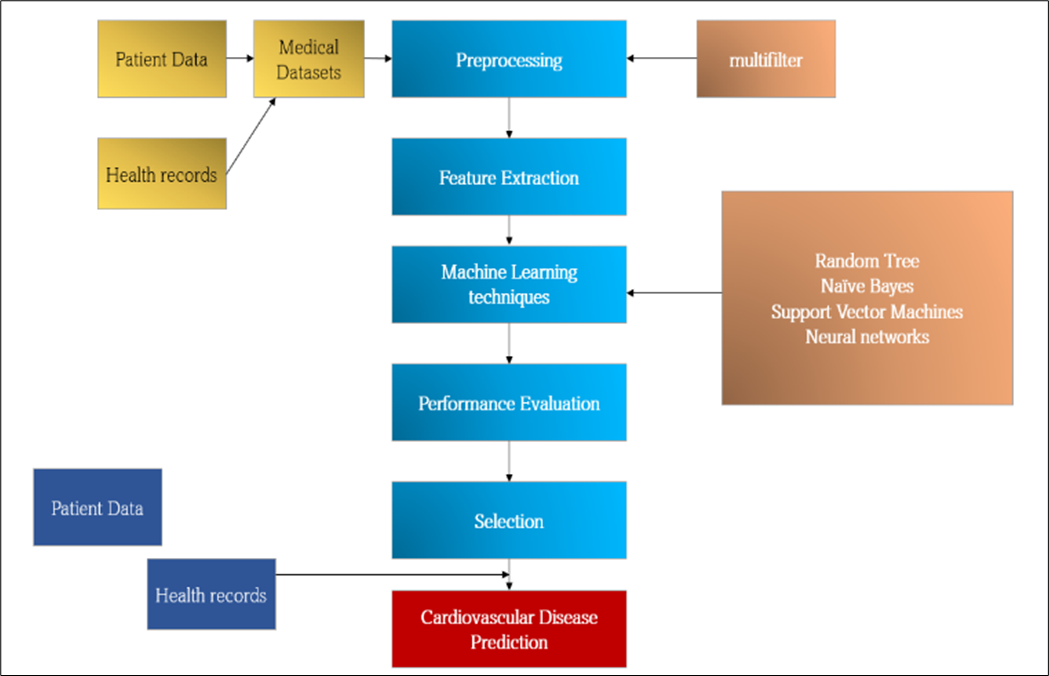Statistical Analysis with Machine and Neural Learning-Based Model on Cardiovascular Diseases and Stroke Prediction
Main Article Content
Abstract
Several risk factors, such as hypertension, hyperlipidemia, and an irregular heart rhythm, make an early diagnosis of cardiovascular disease challenging. Reducing cardiac risk calls for precise diagnosis and therapy. Clinical practice in the healthcare business is likely to evolve in tandem as a result of advancements in machine learning. Therefore, scientists and doctors need to acknowledge machine learning's significance. The fundamental purpose of this research is to a reliable analyzing Risk Factors for Cardiovascular Disease method that makes use of machine learning. Classifying well-known cardiovascular datasets But, on the other hand, is a job for state-of-the-art machine learning techniques and neural network algorithms. Several statistical and visualization indicators were used to assess the efficacy of the suggested approaches and to determine the optimal machine-learning and neural-network approach. Using these modeling methods acquired high and accurate accuracy on stroke and heart disease prediction.
Article Details
References
J. E. Naschitz, G. Slobodin, R. J. Lewis, E. Zuckerman, and D. Yeshurun, “Heart diseases affecting the liver and liver diseases affecting the heart,” Am. Heart J., vol. 140, no. 1, pp. 111–120, 2000.
K. V. R. Kumar and S. Elias, “Real-Time Tracking of Human Neck Postures and Movements,” in Healthcare, 2021, vol. 9, no. 12, p. 1755.
J. P. Li, A. U. Haq, S. U. Din, J. Khan, A. Khan, and A. Saboor, “Heart disease identification method using machine learning classification in e-healthcare,” IEEE Access, vol. 8, pp. 107562–107582, 2020.
V. T. Nkomo, J. M. Gardin, T. N. Skelton, J. S. Gottdiener, C. G. Scott, and M. Enriquez-Sarano, “Burden of valvular heart diseases: a population-based study,” Lancet, vol. 368, no. 9540, pp. 1005–1011, 2006.
K. V. R. Kumar and S. Elias, “Smart Neck-Band for Rehabilitation of Musculoskeletal Disorders,” 2020.
V. Chaurasia and S. Pal, “Data mining approach to detect heart diseases,” Int. J. Adv. Comput. Sci. Inf. Technol. Vol, vol. 2, pp. 56–66, 2014.
K. V. R. Kumar and S. Elias, “Predictive Analysis for Detection of Human Neck Postures using a robust integration of kinetics and kinematics,” arxiv, 2020.
K. U. Rani, “Analysis of heart diseases dataset using neural network approach,” arXiv Prepr. arXiv1110.2626, 2011.
K. V. R. Kumar, B. R. Devi, M. Sudhakara, G. Keerthi, and K. R. Madhavi, “AI-Based Mental Fatigue Recognition and Responsive Recommendation System,” in Intelligent Computing and Applications, Springer, 2023, pp. 303–314.
T. L. V Ulbricht and D. A. T. Southgate, “Coronary heart disease: seven dietary factors,” Lancet, vol. 338, no. 8773, pp. 985–992, 1991.
P. M. Kumar and U. D. Gandhi, “A novel three-tier Internet of Things architecture with machine learning algorithm for early detection of heart diseases,” Comput. & Electr. Eng., vol. 65, pp. 222–235, 2018.
R. Das, I. Turkoglu, and A. Sengur, “Diagnosis of valvular heart disease through neural networks ensembles,” Comput. Methods Programs Biomed., vol. 93, no. 2, pp. 185–191, 2009.
P. Ghosh, S. Azam, A. Karim, M. Jonkman, and M. D. Z. Hasan, “Use of efficient machine learning techniques in the identification of patients with heart diseases,” in 2021 the 5th International Conference on Information System and Data Mining, 2021, pp. 14–20.
R. Kannan and V. Vasanthi, “Machine learning algorithms with ROC curve for predicting and diagnosing the heart disease,” in Soft computing and medical bioinformatics, Springer, 2019, pp. 63–72.
M. Gudadhe, K. Wankhade, and S. Dongre, “Decision support system for heart disease based on support vector machine and artificial neural network,” in 2010 International Conference on Computer and Communication Technology (ICCCT), 2010, pp. 741–745.
A. N. Repaka, S. D. Ravikanti, and R. G. Franklin, “Design and implementing heart disease prediction using naives Bayesian,” in 2019 3rd International conference on trends in electronics and informatics (ICOEI), 2019, pp. 292–297.
E. M. K. Reddy, A. Gurrala, V. B. Hasitha, and K. V. R. Kumar, “Introduction to Naive Bayes and a Review on Its Subtypes with Applications,” Bayesian Reason. Gaussian Process. Mach. Learn. Appl., pp. 1–14, 2022.
N.-S. Tomov and S. Tomov, “On deep neural networks for detecting heart disease,” arXiv Prepr. arXiv1808.07168, 2018.
N. Priyanka and P. R. Kumar, “Usage of data mining techniques in predicting the heart diseases—Na{"i}ve Bayes & decision tree,” in 2017 International Conference on Circuit, Power and Computing Technologies (ICCPCT), 2017, pp. 1–7.
A. Javeed, S. Zhou, L. Yongjian, I. Qasim, A. Noor, and R. Nour, “An intelligent learning system based on random search algorithm and optimized random forest model for improved heart disease detection,” IEEE Access, vol. 7, pp. 180235–180243, 2019.
C. B. Gokulnath and S. P. Shantharajah, “An optimized feature selection based on genetic approach and support vector machine for heart disease,” Cluster Comput., vol. 22, no. 6, pp. 14777–14787, 2019.
Y. K. Singh, N. Sinha, and S. K. Singh, “Heart disease prediction system using random forest,” in International Conference on Advances in Computing and Data Sciences, 2016, pp. 613–623.

